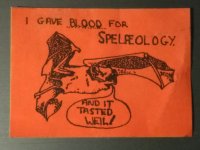Hi all - can anyone remember this?
Many years ago someone was going around obtaining blood samples from cavers at a Hidden Earth event. It was part of a study and involved quite a lot of cavers if I remember correctly. They were testing for ???? in the blood (was it leptospirosos). Any idea who, when, where, what? Were the results published anywhere?
Many thanks if you can share any recollections.
Many years ago someone was going around obtaining blood samples from cavers at a Hidden Earth event. It was part of a study and involved quite a lot of cavers if I remember correctly. They were testing for ???? in the blood (was it leptospirosos). Any idea who, when, where, what? Were the results published anywhere?
Many thanks if you can share any recollections.




